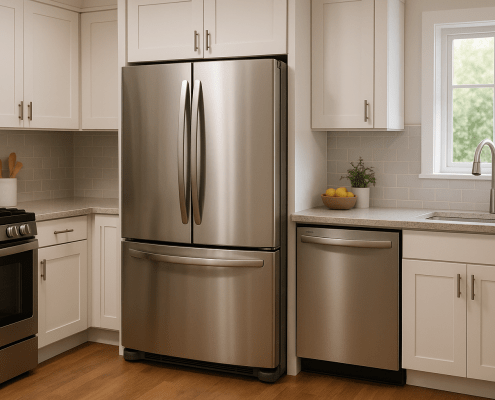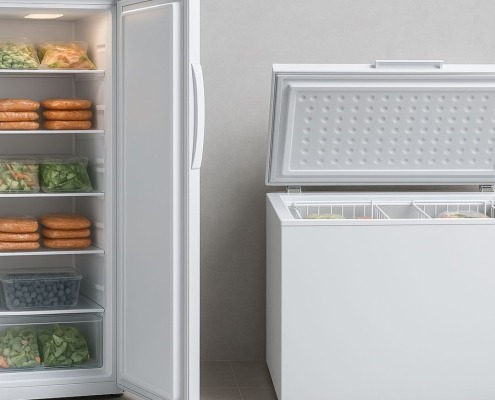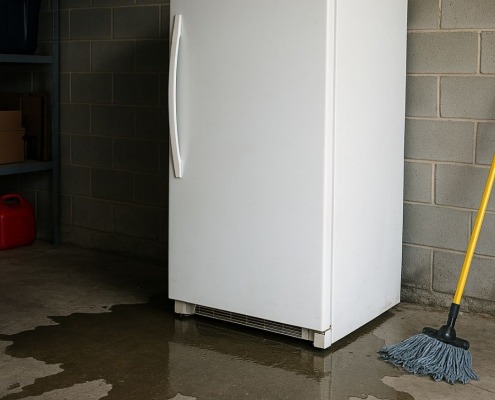Troubleshooting Guide to Fix an Upright Freezer Not Freezing
Steven E / Tuesday May 20, 2025
Is your upright freezer not freezing? An appliance that fails to perform its most basic function can be beyond frustrating. But before you despair at the thought of losing your frozen foods or purchasing a pricey replacement, know there is hope! Many common freezer failures can be fixed with some simple DIY troubleshooting and repair.
We will walk you through the most frequent culprits when a freezer stops freezing properly. With a few tools and safety precautions, you can often diagnose and fix the problem yourself – saving the hassle and expense of a service call.
The information in this article may not apply to your specific appliance model. We recommend consulting your manufacturer’s documentation or contact us with any questions.
Condenser Coils
The refrigeration system that chills your freezer’s interior relies on some key components working in harmony. One vital piece is the condenser coils – a part you’ll find on the back or bottom of your appliance.
These large coil-shaped components act as a heat exchanger, allowing the hot refrigerant gas to dissipate heat as it passes through. This transfer of warmth outside of the system is crucial to dropping temperatures inside the sealed freezer compartment.
Over time, the condenser coils can become clogged with thick layers of dust, pet hair, and other debris. This buildup acts as insulation, preventing the coils from releasing heat efficiently. The result – warm air stops circulating, and the freezer interior warms above freezing temperatures.
Fortunately, cleaning the condenser coils is one of the easiest and most effective troubleshooting steps when a freezer isn’t cold enough. Here’s how to safely give your coils some TLC:
Cleaning Condenser Coils
- Unplug the freezer – This prevents electric shock while you work.
- Remove the lower panel – Consult your model’s manual if needed. This exposes the coils.
- Use a condenser coil brush – Soft bristles dislodge debris better than towels. Brush along the coils’ length.
- Vacuum remains – The brush loosens particles for the vacuum to extract.
- Replace panel and plug in – Once coils are cleaned, reassemble and restore power.
With increased airflow, the condenser should operate efficiently, quickly lowering the freezer’s temperature again. Make coil cleaning an annual routine for optimal performance.
Evaporator Fan at a Standstill
Did cleaning the condenser coils not do the trick? The next component to inspect is the evaporator fan. Located inside the freezer compartment, this often hidden fan circulates air over the evaporator coils.
As cold refrigerant passes through these coils, heat transfers from the air. This chilled air then recirculates throughout the compartment to maintain freezing temperatures. Without the evaporator fan running, this process stops working.
Diagnosing a Faulty Evaporator Fan
A frozen evaporator fan is one of the most common parts leading to cold loss in a freezer. To evaluate the fan:
- Listen for operation – Open the door and listen for fan noise. This fan motor should be running when the compressor is running. No sound likely means a frozen fan.
- Check for obstructions – Ice buildup or other debris can impede the fan blades.
- Test for current – Use a multimeter to check if electricity flows to the fan motor when the compressor is on. If power is at the motor and it’s not coming then you will need to replace the motor.
Defrost Heater on the Fritz
Has a thick layer of frost formed inside your supposedly frosty freezer? The buildup of ice crystals on the evaporator coils can cause cooling issues in another way – by blocking airflow.
This ice accumulation happens gradually each time you open the freezer door, letting in warm humid air. Under normal operation, the defrost heater activates periodically to reverse this frost buildup.
When the defrost heater stops working correctly, ice continues accumulating on the coils over time. The frozen barrier prevents proper air circulation, sending freezer temperatures rising.
Testing a Faulty Defrost Heater
- Use a multimeter to check for continuity – No circuit means it’s time for a new heater.
- Inspect for visible damage – Cracks or blackened areas indicate failure.
Swapping out a burned-out defrost heater restores the automatic defrost cycles your freezer needs. Be sure to clear any existing ice from coils once replaced!
Condenser Fan
While less familiar than the evaporator components, the condenser fan plays an equally crucial role in freezer refrigeration. This fan blows air over the condenser coils discussed previously, facilitating heat release.
A condenser fan failure allows heat to build up rather than dissipating outside the system. Freezer temperatures creep up without the fan properly cooling the condenser coils and compressor.
Evaluating a Condenser Fan Issue
Since the condenser fan is hidden from view, problems with this component often go unnoticed. To properly evaluate:
- Listen for fan sounds – No noise during compressor operation signals an issue.
- Check for debris – Dust or pet fur can stall the fan blades.
- Use a multimeter – Test for power. This should be running when the compressor is on. If power is at the motor and it’s not running the motor will need to be replaced.
Replacing a burned-out condenser fan motor restores necessary airflow across the coils and compressor. This prevents heat buildup so your freezer can chill once again.
Thermostat Stuck
What good is a freezer without accurate temperature control? The thermostat manages power to the compressor, shutting on and off to maintain optimal coldness.
Much like the thermostat in your home, a faulty freezer thermostat can completely throw off ideal conditions inside the appliance. Common problems include:
- Not cycling – Compressor stays on despite reaching temperature.
- Not engaging – Compressor never turns on.
- Incorrect temperature – Keeps freezer significantly warmer than setpoint.
Using a multimeter, you can test your freezer’s thermostat for proper continuity and electrical conductance. Replace the thermostat if readings are outside the specification range.
Control Board on the Fritz
Newer freezer models rely on printed circuit boards – essentially tiny computers – to control all electrical operations rather than individual components. If your freezer has an electronic control board, it’s worth evaluating as part of your troubleshooting process.
Control board issues manifest in different ways:
- Displaying the wrong temperature
- Compressor not engaging
- Evaporator fan not running
- Lights not working
The control board rarely fails on its own – it’s more likely an electrical problem elsewhere is causing a malfunction. But a damaged board can certainly disrupt the precise coordination needed for refrigeration.
Testing the Control Board
- Check all connections – Faulty wiring can impact signals.
- Inspect closely for burnt spots – Indications of an internal short.
- Use a multimeter to check outputs – Should align with wiring diagram specifications.
While replacing a defective control board may seem daunting, manufacturers provide detailed instructions. And this repair restores your freezer’s automated brain.
Maintain Your Freezer to Prevent Problems
Your freezer works hard day in and day out to keep food safely frozen. Take steps to maintain this cooling workhorse and minimize breakdowns:
- Clean condenser coils yearly – Prevent dirt buildup that reduces efficiency.
- Use freezer thermometer – Monitor interior temperature for consistency.
- Keep door seals clean – Avoid ice and debris that reduce integrity.
- Replace worn door gaskets – Make sure you have a tight seal that maintains cold air.
- Don’t overfill freezer – Let air circulate properly for maximum efficiency.
With vigilant preventative care for your freezer, you can keep it freezing food reliably for years to come. Follow these troubleshooting tips at the first sign of temperature trouble. Keeping your cool with your freezer not freezing will help preserve your food and your sanity!
Where To Find Us
If you need any replacement parts for your appliances, you can enter your model number at AppliancePartsPros.com to locate and order them quickly. Most orders arrive in just two business days, and we have tons of great information in our repair help section and YouTube videos to help you troubleshoot.
Stay connected with the latest DIY tips, tutorial videos, and repair guides by following us on Facebook, Instagram, and Twitter. We love hearing about your repair stories and successes. If you need more help or want personalized guidance, feel free to reach out. We’re ready to help you take on your next project with confidence!
With nearly a decade of experience in providing top-notch customer service regarding appliance parts and repair, Steven enjoys sharing practical advice, troubleshooting tips, and interesting information to help readers stay informed.





